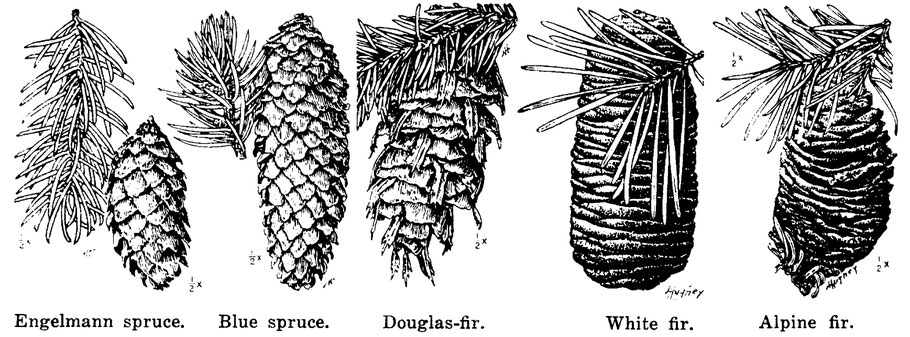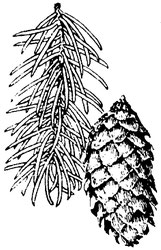Spruces or firs? Notes for the Sandias

Both spruces and firs are in the pine family (Pinaceae) and from a distance, I can't tell them apart. Both grow high in the mountains and are tall and pointy. The Sandia Mountains host two species of fir, Abies concolor (white fir) and A. lasiocarpa (subalpine fir), and two species of spruce, Picea pungens (blue spruce) and P. engelmannii (Engelmann spruce). Because that's not complicated enough, Douglas firs, which are common in the Sandias, are not true firs (they're not in Abies but in Pseudotsuga). In other mountain ranges, other combinations of species will be present. But let's focus on what you'll see in the Sandias. Also, let's start by trying to tell a spruce from a fir, and both of those from a "Doug fir." In other words, an ID to the genus level will suffice.
If you see obvious cones on a tall, pointy tree, from a distance, those are female cones (the male cones are inconspicuous). If the the cones go up from branches (i.e., are erect), that's a true fir. If the cones hang down from branches, that's either a spruce or a Douglas Fir. So with a little luck, even from a distance you'll be able to start your ID.
If you can, though, approach the tree and look at the individual needles. Spruce needles are square in cross section, and roll easily between your forefinger and thumb. Fir needles are "flat" (wide and thin) in cross section, and don't want to roll between your forefinger and thumb. Many people use an adage to remember that difference. The version I learned is "Spruce square, fir flat." So If the needles are square in cross-section, you have just identified a spruce (Picea). The confirmation being that any obvious cones on the tree are hanging, not upright.

If the needles are "flat: in cross-section, the tree is either a true fir (Abies) or a Douglas fir (Pseudotsuga menziesii). The easy next step is to look at the ground beneath the tree. The cones on true firs disintegrate up on the tree, so there shouldn't be a bunch of cones lying beneath them. Beware of cones that washed downhill, from another tree, but otherwise the flat needles plus the lack of cones on the ground indicates that you're looking at a true fir. Remember that any obvious fir cones on the tree should grow up from the branch, not down.
If there are lots of cones at the base of a tree with flat needles, and if there are papery trident-looking things (bracts) sticking out between the scales of the cones, those are Douglas fir cones. You can see an example to the left. If there are cones on the tree they'll hang from the branches, instead of being upright.
Congratulations! You now know how to ID the tall pointy trees of the Sandias down to the genus level: spruces versus true firs versus Douglas fir.
If you're not going to be happy without an ID to the species level, the rest of this page will help. Maybe. Let's start with the image shown immediately below. It's a composite of drawings by Leta Hughey.* "Alpine fir" is a synonym for subalpine fir,** so the image shows the five spruce and fir species of the Sandia Mountains. You can print out this image and leave it in your pack for reference. Later I'll go over the individual species, including Elbert Little's comments in the publication where I found Ms. Hughey's drawings.

The Spruces

Blue spruce (Picea pungens). "Also called Colorado blue spruce, Colorado spruce, silver spruce ... conical crown of bluish foliage, at least on young trees and parts. Twigs roughened by peglike bases of fallen needles; twigs and leaf bases usually not hairy. Needles 4-angled, 3/4 to 1 1/8 inches long, stiff and spine-pointed, dull blue green or silvery blue or becoming darker on older parts. Cones 2 1/2 to 4 inches long, light brown, with scales more or less straight across apex and not thinner. Bark rough and thick, furrowed into scaly ridges, gray or brown."

Engelmann spruce (Picea engelmannii). "Also called white spruce, mountain spruce, silver spruce ... narrow, pointed conical crown and horizontal or slightly drooping branches extending nearly to ground; or at timber line dwarfed and bushy. Twigs roughened by peglike bases of fallen needles; twigs and leaf bases usually hairy. Needles 4-angled, 5/8 to 1 1/4 inches long, pointed but not stiff, dark or pale blue green, with disagreeable odor when crushed. Cones 1 1/2 to 2 1/2 inches long, light brown, with papery scales more or less rounded and distinctly thinner at apex. Bark thin, with loosely attached scales or flakes, grayish to purplish brown."
There seems to be no idiot-proof way to know which of these two species you're dealing with. Instead, you need to look at various traits. A tree may look more like a blue spruce, based on one trait, more like an Engelmann based on another. For some spruce trees, you may not be able to decide which species you're dealing with. You can see how other people have presented the distinctions here and here.
How do you measure how long cones are, when they're at the top of a tree? The needles on both blue spruce and Engelmann spruce are roughly 1 inch long. If the cones are at least 2 1/2 times as long as the needles, often longer, think blue spruce. If the cones look barely longer than the needles, think Engelmann spruce. But blue spruce trees sometimes grow short cones, so base your evaluation on as many cones as you can.
True spruce cones make it to the ground, unlike fir cones, so you can measure them there. But beware of cones washing downslope from another tree.

If you see cone-like things at the very end of spruce twig, similar to the one I show to the left, those aren't cones. They're galls produced by gall adelgids, a species of true bug.
Spruce needles have sharper tips than fir needles, as you may realize when you grasp a twig. But what concerns me here is the new-growth twigs, not the needles. Blue spruces have "glabrous" new twigs, meaning that the surfaces of the twigs are smooth. New Engelmann spruce twigs are sometimes "hairy," meaning that there's a fine fuzz on twig surfaces. My sense is that if any of the newest twigs on a tree are hairy, that's an Engelmann, but if you don't find a hairy twig, that doesn't mean much. Also, unless your eyesight is excellent, use a hand lens to look for those hairs. They're tiny.
As spruce bark gets older, it tends to be more flaky than furrowed. On older blue spruces, that bark should tend to be gray, except in cracks in the bark, and more furrowed than on an Engelmann. On older Engelmann spruces, the bark should tend to be cinnamon-colored and the flakiness should be obvious. Hard and fast rule? Not that I can see.
The True Firs
These divide more cleanly than the two spruces in the Sandias, so I'll deal with them in turn.

White fir (Abies concolor). "Also called balsam fir, silver fir, white balsam ... pointed conical crown becoming irregular in age. Needles spreading and curved upward, flat, 1 1/2 to 2 1/2 inches long, usually blunt, pale blue green or silvery. Cones in top of tree, upright, 3 to 5 inches long, usually grayish green, with scales falling apart at maturity. Bark on small trunks smoothish, gray, becoming very thick, hard, and deeply furrowed into scaly ridges.
White fir is the spruce/fir I encounter most often in the Sandias. White firs have both male and female reproductive parts. Easy to tell those apart, though. The female reproductive parts become the cones at the top of the tree; those are large and often upright. Once mature they fall apart, so don't expect to find cones from previous years. You may, however, notice upright "spikes" on the tree; those are the remnants of female cones.
The male flowering parts are small and inconspicuous, and on lower branches. There's a reason for the arrangement: pollen is more likely to drift down than up, so each tree's female flowers (high up) are unlikely to be pollinated by its own male flowers (low down).

Subalpine fir (Abies lasiocarpa). Little refers to this as alpine fir. "Also called white balsam, white fir (lumber) ... dwarfed and shrubby at timber line. Crown long, narrow, and sharp-pointed, with branches extending nearly to base of tree. Crown long, narrow, and sharp-pointed, with branches extending nearly to base of tree. Needles spreading or sometimes in 2 rows, 1 to 1 3/4 inches long, blunt, or on uppermost branches pointed and shorter, dark blue green. Cones in top of tree, upright, 2 1/2 to 4 inches long, dark purple, finely hairy, with scales falling apart at maturity. Bark becoming fissured and scaly, gray; in the variety corkbark fir, bark soft, spongy or corky, smoothish, thin, creamy white."
Subalpine fir bark, while rough, is continuous. Enough so that some visitors to the top of the Sandias carve their initials in the bark (you can see a large M in one picture). My IDs of subalpine fir trees always begin with the bark.
Pseudotsuga

Douglas fir (Pseudotsuga menziesii). "Also called Douglas-spruce, red fir, yellow fir, common Douglas fir, Oregon pine (lumber) ... with open, broadly conical crown and drooping lower branches. Twigs slightly roughened by bases of fallen needles. Needles spreading on all sides of twigs or sometimes in 2 rows, short-stalked, flat, 3/4 to 1 1/3 inches long, rounded at apex, dark blue green. Cones 1 3/4 to 2 3/4 inches long, reddish brown, with thin, rounded scales and long, distinctive, 3-pointed bracts projecting beyond the scales. Bark rough and very thick, deeply furrowed into broad ridges, sometimes very corky, dark reddish brown or gray."
As I mentioned earlier, the best way I know to identify a "Doug fir" is to notice the distinctive cones, including on the ground beneath a mature tree. Unlike the cones of "true" firs (Abies), Douglas fir cones reach the ground in one piece. For branches that aren't way over your head, look for soft needles (flat in cross-section) in a bottle-brush arrangement, and for prominent brown buds at the tips of branches.
*The images appear on Pages 19 and 21 of Southwestern Trees: A Guide to the Native Species of New Mexico and Arizona (1950; reprinted 1968), by Elbert L. Little, Jr. Agricultural Handbook No. 9. USDA Forest Service; U.S. Government Printing Office, Washington, D.C. The report is available online. Ms. Hughey was not listed on the title page but was credited on Page 4.
**Abies lasiocarpa, the subalpine fir or Rocky Mountain fir, includes a regional variant, cork-bark or corkbark fir, in Arizona and New Mexico.





























































